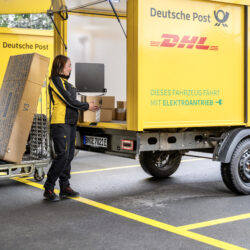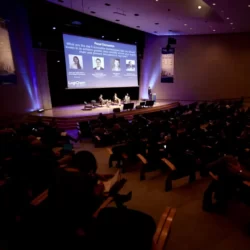Digital twin helps DHL to reduce transport flows

DHL customers flew to Valencia from around the world to spend two days immersed in the topic of sustainability. The company revealed impressive figures on its investments into ‘greening’ all its transportation operations. However, this detracted attention from DHL’s other efforts to reduce transport rather than just making it more sustainable.
By Marcel te Lindert
Deutsche Post DHL’s operations generated 36.5 million tons of carbon emissions last year, of which 69% came from air cargo operations. But while air freight offers the biggest opportunities for reducing carbon emissions, it also presents the biggest challenges. DHL likes to be associated with images of sleek, electrically powered aircraft in the company’s red/yellow colours, but in fact the actual deployment of emission-free cargo aeroplanes is still some way off. “We’re closely monitoring the advancements in the electrification of aircraft, but the technology is not yet mature enough for us to make a start with it. We still have a long way to go, especially in terms of the technological scalability”, said Yin Zou, Executive Vice President of Corporate Development at Deutsche Post DHL.
Instead, DHL is focusing on acquiring more fuel-efficient aircraft, loading cargo space more efficiently, optimizing the air cargo network and, above all, sustainable air fuels (SAFs) which are made from renewable plant-based or synthetic raw materials. SAF production is still in its infancy and currently only meets a fraction of the aviation sector’s total fuel needs. DHL stakes a claim to 18.5% of that fraction, but it’s nowhere near enough. “Our 2030 goal is for more than 30% of the jet fuel we use to be SAFs. We’re stimulating the construction of SAF plants and are establishing partnerships to secure SAF sourcing,” Zou added.
Road transport
In the meantime, DHL is making great strides in deploying clean energy in areas where the technology is already advanced enough. One example is road freight, which accounts for around 20% of DHL’s global carbon emissions. The company’s transport fleet currently has 30,000 electric delivery vehicles, equating to 23% of the total fleet, but the goal for 2030 is 60%. “We are well on our way to achieving that, especially in Germany,” he continued.
In stark contrast to this, DHL has just 30 electric trucks in its fleet for transport between its warehouses, sorting centres and delivery hubs. “Electrifying this type of road transport is a lot more complicated. The big question is whether batteries or hydrogen will become the dominant technology. We’re discussing this with all the major truck manufacturers and testing all kinds of things,” stated Zou.
Perhaps the least challenging aspect, sustainability-wise, is the company’s 36 million square metres of logistics real estate. Since 2021, all new facilities have been built to be carbon-neutral, and more than 90% of the electricity consumed in them comes from green sources. However, the footprint of all DHL’s logistics real estate is negligible compared to the company’s overall footprint.
GoGreen Dashboard
During the customer event in Valencia, DHL explained about its ultimate goal: complete carbon-neutrality by 2050, and emissions reduced to below 29 million tons by 2030. “We were at 36.5 million tons last year, but that will keep rising unless we take action. To meet our target, we still need to save about 10 million tons of CO2. That’s why we are investing a further seven billion euros in reducing carbon emissions in the coming years,” Zou claimed.
Faced with so much information about the greening of transport activities, customers could have been forgiven for almost forgetting the most important solution for reducing emissions: eliminating transport. But in the exhibition area, DHL showed how customers could make a start on that: first by defining their sustainability strategy and then by measuring their footprint. In the context of the footprint, DHL has developed the GoGreen Dashboard: a single dashboard that gives customers a consistent view of emissions related to all DHL operations, from warehouses to express services.
Developing that dashboard was more difficult than it might seem due to the company’s structure as multiple independently operating divisions. “But we’ve succeeded, and customers can sign up now. We will start rolling out the dashboard in the course of this year,” said Carsten Lützenkirchen, who as Senior Vice President is responsible for Customer Solutions & Innovation. That is an umbrella department that spans all the divisions, creating tighter links between them in order to better address customer needs and helping to drive the development of innovative ideas into marketable solutions.
DHL’s digital twin
An even more interesting tool is the digital twin that DHL is in the process of developing. This will allow the logistics provider to create a digital copy of a customer’s supply chain which can be used to analyse scenarios, such as how creating more local stock points would affect emissions, and the consequences of using sea freight instead of air freight.
“With the digital twin, we can optimize and therefore reduce transport flows. We have just developed an alpha version that we are presenting here in Valencia. Soon, we will release a beta version that we can use to analyse and optimize customers’ supply chains,” explained Lützenkirchen. His colleague Katja Busch, Chief Commercial Officer at Deutsche Post DHL, added: “Supply chain optimization is definitely on our agenda. First burn less, then burn clean. To achieve this, we’re using data, algorithms and artificial intelligence. We’ve developed this tool in close collaboration with a warehousing customer.”
Resilience
The terms ‘sustainable supply chains’ and ‘resilient supply chains’ often go hand in hand. DHL used to have its own solution for detecting and monitoring supply chain risks: Resilience360. However, that division merged with Riskpulse and became independent under the name Everstream. “It’s a very successful company that recently received a capital injection of 15 million euros,” said Busch. “We are still a major investor in Everstream, but it’s a purely data-driven company. We don’t think we are the best environment for such a company. But we do think it’s important to participate in Everstream and we still use its tools.”
DHL sees an important role for itself when it comes to supply chain optimization. “It’s something that we’ve always done. Customers approach us every day with questions about reducing, accelerating or saving costs on their transport flows,” commented Lützenkirchen. “But eventually you reach a point when further optimization is no longer possible. You still need to arrange transport, and that’s when our sustainability measures come in useful, such as our investments in electric vehicles and sustainable aviation fuels.”










